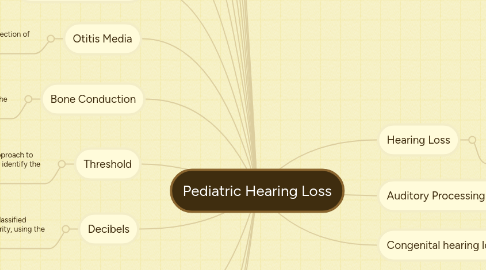Pediatric Hearing Loss
Nawal Javaidにより

1. Prelingual hearing loss
1.1. Hearing loss occurs soon after birth but before a child has developed language
2. Poslingual hearing loss
2.1. Hearing loss occurs in later childhood or adolescence after language skills are well established
3. Deaf
3.1. Often refers to those persons whose hearing loss is severe
4. Types of Loss
4.1. 1.
4.1.1. Conductive hearing loss
4.1.1.1. Caused by damage to the outer or middle ear, with the inner ear and cochlea intact
4.2. 2.
4.2.1. Sensorineural hearing loss
4.2.1.1. Caused by damage to the cochlea or the auditory nerve, with the outer and middle ear intact
4.3. 3.
4.3.1. Mixed hearing loss
4.3.1.1. Caused by damage to both the conductive and sensorineural mechanisms
5. Decibels
5.1. Hearing loss is also classified according to its severity, using the decibel system
6. Threshold
6.1. The prevailing approach to hearing loss is to identify the threshold
7. Bone Conduction
7.1. The transmittal of sound vibrations along the bones of the skull
8. Otitis Media
8.1. A viral or bacterial infection of the middle-ear space
9. Otocoustice Emissions
9.1. A measure of cochlear function
10. Evoked auditory potentials
10.1. A measure of the electrical response of the auditory system to a sound stimulus
11. Otoscopic examnination
11.1. Detects any abnormalities in these structures and to ensure a clear external auditory canal prior to testing
12. Audiometry
12.1. Also called pure-tone testing, provides objective information about hearing acuity
13. Air Conduction
13.1. The way most sounds are delivered to the cochlea and auditory pathway
14. Immittance
14.1. Describes the acoustic flow of energy through the middle-ear space
15. Tympanometry
15.1. A tool which examines tympanic membrane movement, or vibration.
16. Probe microphone measurement
16.1. Real ear testing
17. FM system
17.1. Most common ALD used by children, it's a personal amplification system that can be used independently or with hearing aids.
18. Cochlear implant
18.1. A surgically placed device that provides direct electrical stimulation to the auditory nerve
19. Hearing Loss
19.1. Refers to the condition in which a child or adolescent is unable to detect or distinguish the range of sounds normally available to the human ear
20. Auditory Processing Disorders
20.1. Hearing losses resulting from damage to the processing centers of the brain
21. Congenital hearing loss
21.1. Hearing loss may be present at birth


